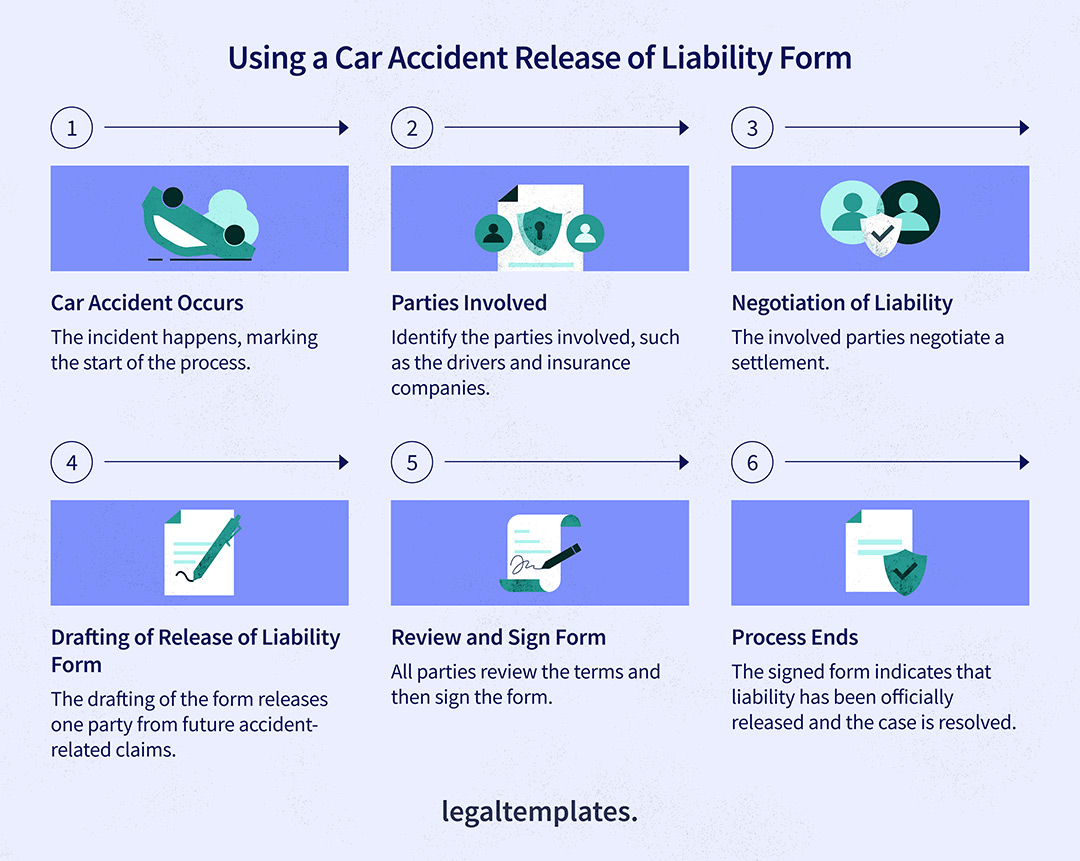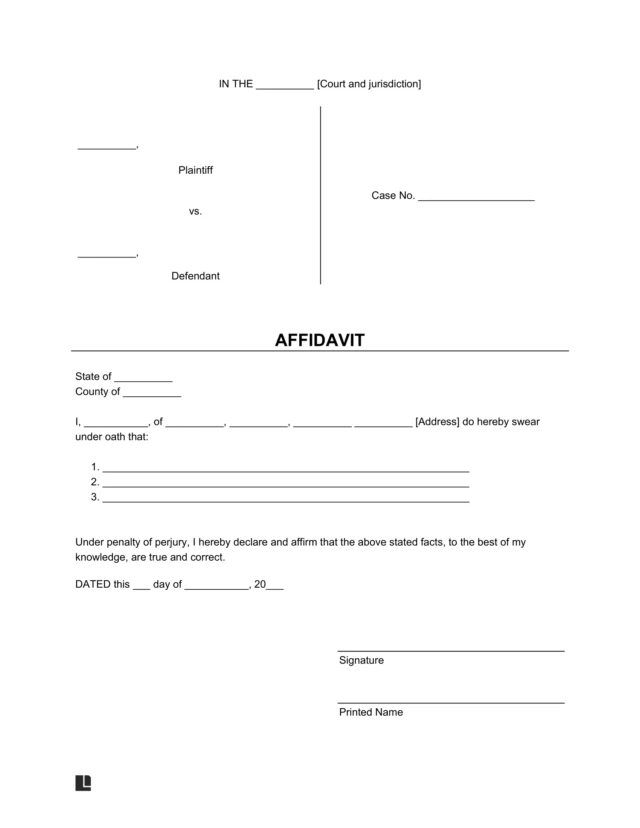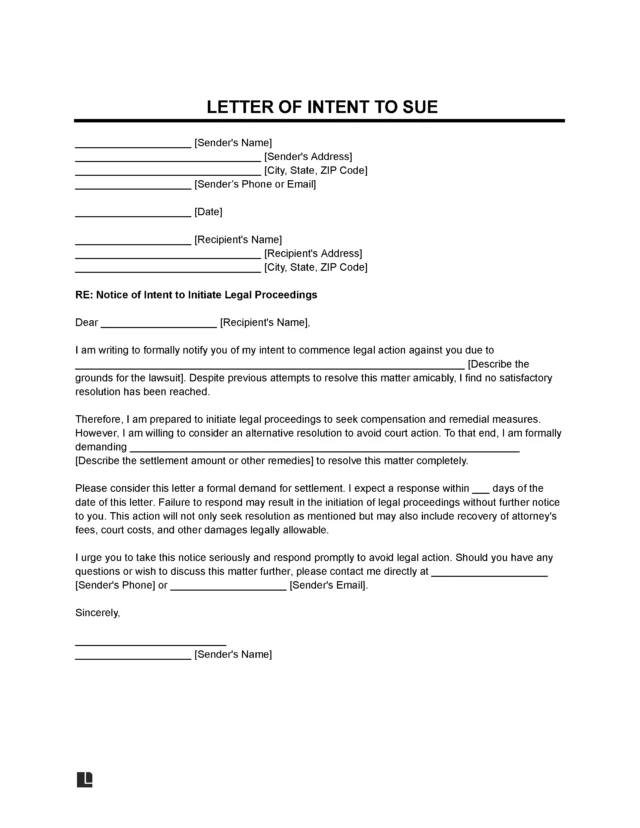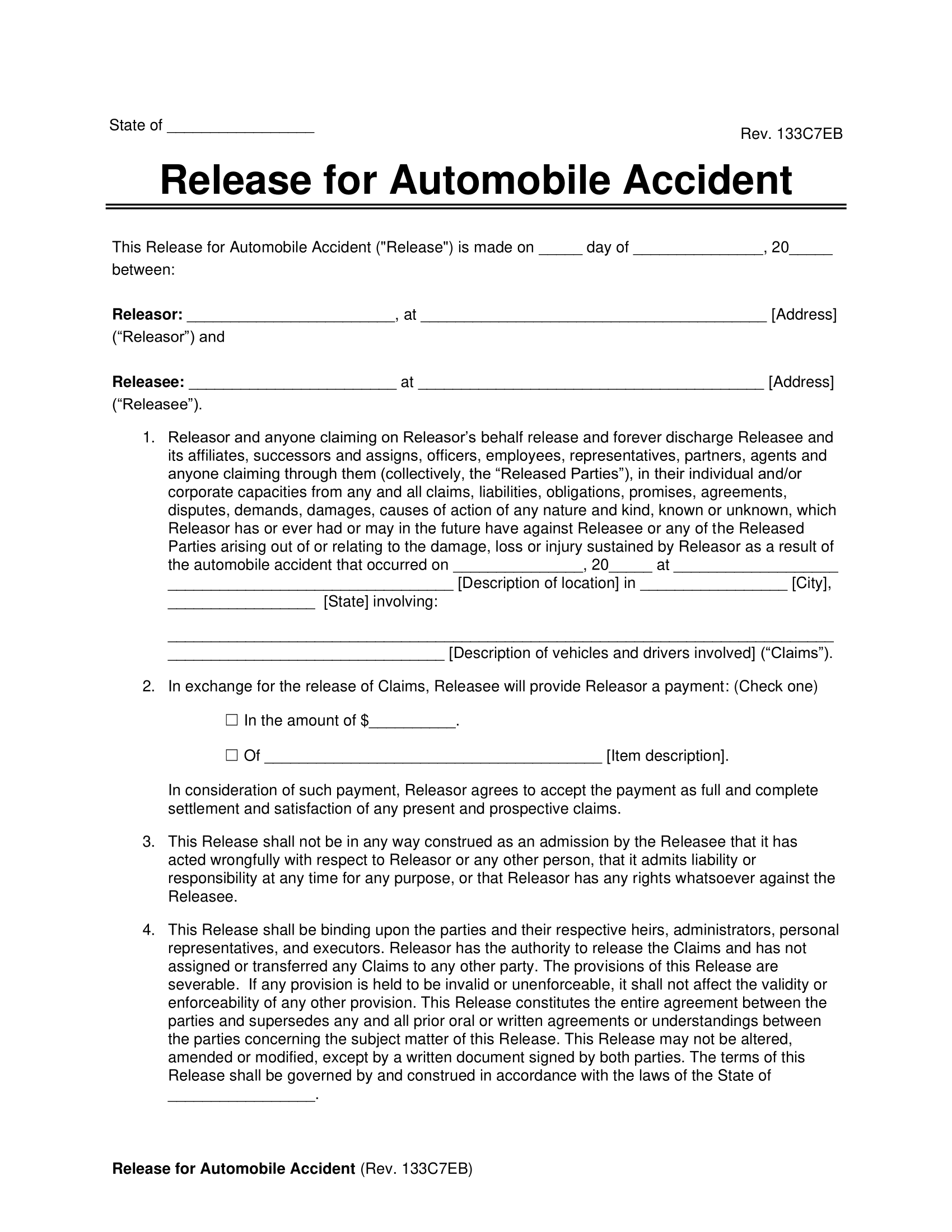What Is a Car Accident Release of Liability Form?
A car accident release of liability form is a legal document that helps settle a car accident claim without going to court. It lets both sides agree on a payment, called compensation, that the person at fault (the releasee) offers in exchange for being released from future claims. This money might cover medical bills, lost wages, car repairs, or pain and suffering.
Once both people sign the form, the other party (the releasor) gives up the right to ask for more money from the driver or insurance company. Our form helps you complete the agreement and resolve the claim.
What if Both Parties Involved Are at Fault?
Use a bilateral contract like a mutual release of liability form if both parties are at fault. This way, neither party can bring legal claims against the other at a future date.
When to Use a Car Accident Release Form
Here are some situations when you might use an auto accident release of liability form:
- when the parties wish to limit the involvement of insurance companies
- when the parties wish to settle the matter privately
- when the accident results in minor property damage but no injuries
- when the parties want to ensure no additional claims or lawsuits arise later
- when the parties agree on the compensation that should go to the releasor
How Does a Car Accident Release of Liability Form Work?

After a car accident, the at-fault party and their insurance company may have to compensate the victim to waive further claims. A car accident release form helps the parties negotiate a settlement and agree on terms. Here’s how it works.
1. Gather Information About the Accident
Collect evidence of the accident damages, including:
- photos of injuries or damaged property
- estimates to repair the property
- police accident reports
- related medical and financial records
- documentation of any lost wages
What if the Accident Involved Multiple Vehicles?
For accidents involving multiple vehicles, it may be best to go through the legal system instead of reaching a settlement outside court. The complexities of a multi-vehicle accident make a settlement challenging.
2. Assess Damages
Give the car accident victim time to assess damages, such as physical injuries, property replacement costs, and mental anguish. Hold off on writing the agreement until the victim is recovered. This way, they can assess their injuries and avoid the cost of hidden damages.
3. Negotiate a Settlement
The injured party determines the compensation they believe their accident claim is worth and negotiates a settlement. They may send a demand for payment letter or a personal injury demand letter to the at-fault driver.
Avoid paying a settlement agreement without an accompanying signed release of liability form. Otherwise, you could still be liable for future claims.
4. Write & Sign the Car Accident Waiver
Write the car accident release of liability waiver. Both parties should sign the contract and keep a copy for their records.
Should I admit fault?
When writing a release of liability form for a car accident, it’s essential to never admit fault. Even if you were partially or mostly at fault, admitting fault in writing could be used against you later. Insurance companies may also deny coverage if you admit fault outright.
Instead, keep the car accident release of liability waiver neutral. Focus on the parties’ mutual agreement to settle the matter, and let the document speak for itself. When you use Legal Templates’s form, you get legal protection without needing to make an admission.
How to Write a Car Accident Release of Liability Form
Write a simple car accident settlement agreement form and ensure it’s legally valid by following these steps.
1. Check State Laws
Some states ban or limit liability waivers when an at-fault party displays gross negligence. Intentional misconduct and recklessness can also restrict the signing of a liability waiver. In these cases, the parties may have to undergo legal proceedings to reach an outcome. Check your state’s laws before proceeding with this agreement.
2. Name the Releasor & Releasee
Fill in the names and addresses of the releasor (the party giving up the right to future claims) and the release (the party at risk of being sued).
3. Give a Claims Description
Provide details of the accident, including when and where it occurred, what happened, and who was involved. Be as descriptive and specific as possible.
You must understand the types of claims being waived. Legal Templates provides a release of all claims form for a car accident. This means that the releasor waives any claims related to the accident. It simplifies the release, as they won’t be releasing some claims, like property damage, while leaving others open, like bodily injury.
4. Describe the Settlement Amount
Include compensation to be exchanged in the settlement agreement and how it will be paid. Our form lets you fill in a dollar amount or list an item provided in exchange for the release of liability.
Ensure that you account for all damages caused by the accident. These include:
- property damage
- medical bills
- future medical expenses
- loss of wages due to missed work
- pain and suffering
- emotional distress
Add up these damages to determine a fair compensation amount. Negotiate a fair settlement with the releasor to ensure satisfaction from both parties.
5. Finalize Details
Record the date the agreement is finalized and the state that governs it. Indicate whether you want the form to include signatures from witnesses or a notary acknowledgment.
Ensure that all parties sign the agreement freely and willingly. They should not feel threatened or coerced into signing. If either party signs under duress, the contract won’t be valid.
Car Accident Settlement Agreement Sample
View a free release of liability form for a vehicle accident to see what elements are included. When you’re ready, you can write your own using our car accident settlement agreement template and save it as a PDF or Word document.
Settle Your Car Accident Liability with Confidence
Going through a car accident is a difficult experience, but Legal Templates is here to support you. Fill out our car accident release of liability template to reach a settlement with the other party and stop future claims.
Our form lets you input the details specific to your accident. We’ve perfected the legal language so you can clearly communicate the release of liability in exchange for compensation. When you complete the form, you can save and print it, allowing for convenient storage in your records. With this easy access, you can refer to it if the other party tries to pursue additional claims.
Power of Attorney for Car Insurance
Prepare a power of attorney for car insurance purposes in case you cannot make decisions following an accident. This allows you to discuss your wishes regarding liability release and settlements with the agent you appoint in advance.
Frequently Asked Questions
How long do car accident settlements take?
Car accident settlements may take a couple of weeks, several months, or even years to finalize. It depends on the severity of injuries, whether both parties agree on the compensation, and whether insurance companies green-light a settlement agreement.
Can I claim anxiety after a car accident?
Yes, you can claim anxiety and emotional distress as part of non-economic damages following a motor vehicle accident. Consult your state’s laws to determine the exact type of damages you can recover. For example, Florida’s Impact Rule requires claims of emotional distress to be tied to a physical injury.
If I accept a settlement, do I need to sign a vehicle accident release of liability form?
You must sign a release of liability form if the releasee asks for one as a condition of the settlement. Some insurance companies require a release of liability as a term of settlement.
Does having a car accident release of liability mean you can’t be sued?
Once an injured party signs a motor vehicle accident release of liability form, they waive the right to ask for additional compensation or bring legal action against the at-fault party, even if future damages are later discovered.
Should I inform my insurance agent about the accident?
Some insurance companies require pre-approval before signing a release of liability form, so it’s a good idea to inform your insurance agent about the accident.






